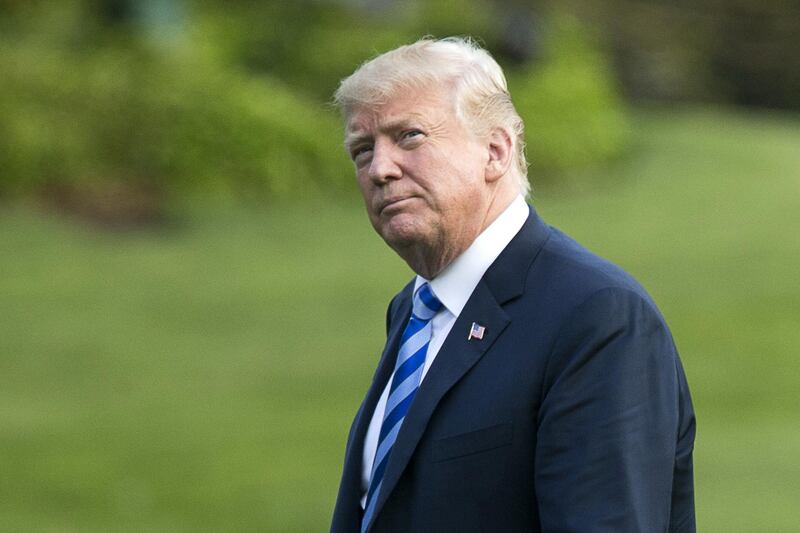President Donald Trump will next week be making one of his most consequential policy decisions on the Middle East by determining whether Washington will remain part of the 2015 international agreement on Iran’s nuclear programme.
Mr Trump has stuck to his niche of unpredictability and has kept many people guessing on what his decision will be as the May 12 deadline approaches.
The National has gathered a list of Mr Trump's options on the Iran nuclear deal and ranked their likelihood based on insights from multiple diplomatic sources and expert opinions in Washington.
1. Most likely: Trump does not certify the deal but waits before imposing new sanctions
Under this option, Mr Trump will not certify the deal by refraining to send Congress a letter to waive US sanctions imposed on Iran prior to 2015. Technically, this would mean that the Trump administration took its first step to pull out of the agreement.
However, this option does not mean that the US has completely withdrawn from the deal, which does not offer provisions for leaving it. The agreement is based on implementation, which for Washington pertains to waiving sanctions under the Iran Nuclear Agreement Review Act every six months.
In this case, Mr Trump would have allowed Congress 60 days to decide on whether to impose new sanctions. During this period, US Secretary of State Mike Pompeo and John Bolton, the president’s national security adviser, could negotiate with the Europeans a new framework or use the threat of fresh sanctions to bring Iran to the negotiating table — something Tehran has so far rejected.
This option will allow Mr Trump to rally his base and fulfil his campaign promise not to certify what he called an “insane” and “ridiculous” deal but without completely upending negotiations with the Europeans, who still endorse the agreement.
2. Possible: US withdraws from deal and imposes limited sanctions
This option would mean that the Trump administration announces it is leaving the accord and that it intends to impose sanctions that target Tehran’s nuclear and ballistic missile programmes. It would not go as far as imposing secondary sanctions that would target European banks doing business with Iran, as that could fracture the transatlantic alliance.
3. Also possible: US remains part of deal temporarily
While most people in Washington, along with French President Emmanuel Macron, believe Mr Trump will withdraw from the nuclear agreement, the US leader may still prove them wrong.
Congressman Mark Meadows, a Republican close to Mr Trump, told The Daily Beast in an interview published on Friday that he "would not necessarily draw a foregone conclusion that we're out this month".
He added: “To suggest that it’s a foregone conclusion that we’ll be out in weeks would be inaccurate based on my conversations with some of my colleagues on Capitol Hill, both Democrat and Republican.”
The White House has insisted that Mr Trump has not yet made a decision.
Agreeing to temporary stay part of the deal will depend on the fixes that Europeans offer. This option would allow Mr Trump to temporarily preserve the French-US-German alliance on Iran and seek better reinforcement or renegotiate the deal.
4. Less likely: Trump abandons deal and slaps sanctions that target European firms
This option would mean that the US completely withdraws from the Iran deal, as it did with the Trans-Pacific Partnership and the Paris Agreement. It would also mean that Congress will be authorised to approve secondary sanctions — which pertains to foreign institutions, including Europeans ones doing business with Tehran.
This would inflict the most damage on the Iranian regime, but it would also fracture US-European relations and hurt business ties.
5. Not likely: Trump commits to deal and enforces it
This would mean that Mr Trump had made a 180 degree shift and accepted the nuclear agreement even if the negotiations with the Europeans fail to reach a new framework. It would force the US to commit to the implementation of the deal as a non-proliferation measure, while seeking a different framework at a later stage.
This option, however, remains highly unlikely given Mr Trump’s long-standing opposition to the deal and that he is seeking a reversal from the Obama era rather than continuity.
6. Least likely: Trump withdraws from deal and threatens military action
This option would mean that not only did the US withdraw from the deal, but it has also threatened military action against Iran if it pursues enrichment of uranium.
Iranian Foreign Minister Javad Zarif has threatened that Tehran would resume “vigorous” enrichment if the US leaves the deal. Mr Trump, in response, said that Iran “will have bigger problems than they have ever had before” if it did so.
Hardliners in the Trump administration, including Mr Bolton and Mr Pompeo, may see a benefit in bringing back a military threat against Tehran, but they will likely face a pushback from Secretary of Defence Jim Mattis, Congress and Washington’s European allies. This make a military threat less likely, yet possible.
The US president is expected to make a final decision by Saturday.






